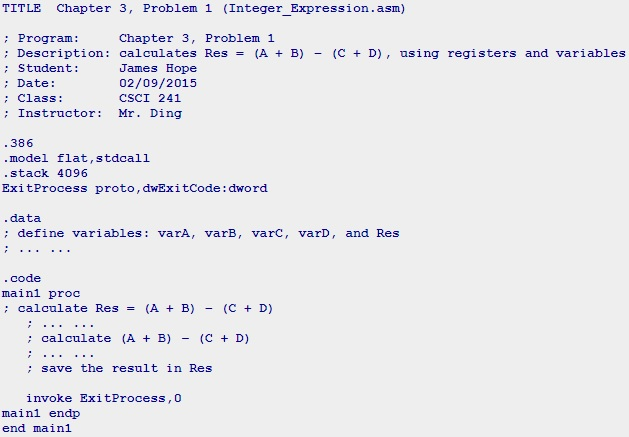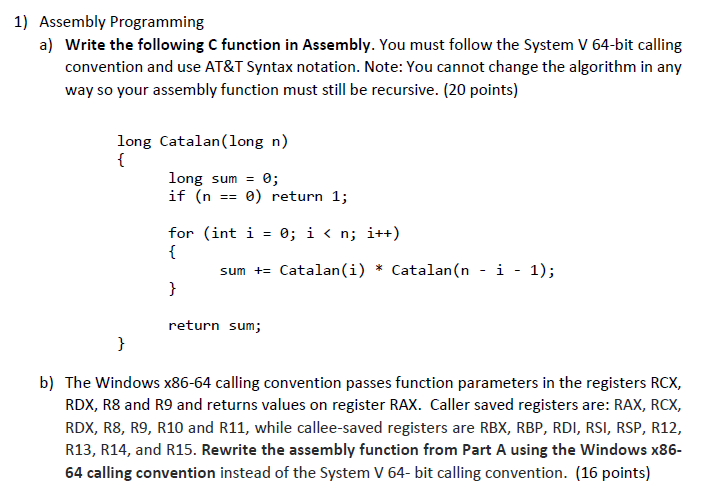

- How to write c code to yield the following assembly code how to#
- How to write c code to yield the following assembly code 64 bits#
- How to write c code to yield the following assembly code windows#
Line 12 – Calls the GetForegroundWindow(). Lines 8, 9, 10 – correspond to the last 3 arguments of MessageBoxA (namely: uType, lpCaption, and lpText). Lines 6,7, 16 – The inline assembler block. Lines 3, 4 – Declaring a couple of constant C strings. Lines 1,2,17 – Normal function declaration constructs. Static const char* msg = "Hello world from x86 assembly language!" MessageBoxA(GetForegroundWindow(), msg, info, MB_OK) void hello_world_asm() In the following example, we write the assembler equivalent of the following C code: Example 1 – Hello world from Win32 inline assembler Now, let me dive in directly by writing examples and explaining them. If the emitted machine byte codes do not correspond to valid instructions then your code may cause exceptions. It is also possible to use “ _asm ASM x86_instruction” to emit one instruction at a time (without opening a block).Īnother way to emit machine code is to use the “ _asm _emit byte_value” to emit an arbitrary machine code. 
To write inline assembler code, you just have to use the _asm keyword, open a code block then close the block to terminate the inline assembler code. Please remember that the presented code is for illustration purposes only and is not meant for production. I will start with easy ones and end with hard ones.
Naked functions containing purely assembler code. Inline assembler code, mixed with C code in the same function. How to write c code to yield the following assembly code how to#
The main focus of this post will be how to write inline assembler code inside your C/C++ functions. When being called as an stdcall function, make sure you purge the stack before returningįor more information, check the “ x86 Architecture” article on MSDN.When calling cdecl functions make sure you purge the stack upon returning.Respect calling conventions if you call functions or if you are called.You can modify those registers but make sure you restore them Do not mess the stack or frame pointer.The register EAX alone is used to return a 32 bits integer value
How to write c code to yield the following assembly code 64 bits#
On x86, the EDX:EAX register pair are used to return 64 bits integer values. All registers must be preserved except for EAX, EDX, ECX and ESP. 
The compiler expects certain non volatile registers to be preserved between function calls Here are some stuff that you need to keep in mind when writing assembler code:
The “Auto” window: it will automatically show relevant variables around the currently executing statement. When debugging you get to see the disassembly code equivalent of your C code The disassembly window, docked next to the source code window. The registers window: useful to see the values of general purpose registers. The memory window: it is useful to inspect contents of memory pointed by the registers or pointers. How to write c code to yield the following assembly code windows#
This is how my windows layout is when I am debugging the sample code in this article: To show those windows, go to the “Debug / Windows” submenu: Now when you debug the code, it will be useful for you to show the registers, disassembly (when needed) and the memory window.
Choose “Templates / C++” then “Win32 console application”. Run Visual Studio (or press Windows-Key+R, then type “devenv”). Understanding of various calling conventions ( stdcall, cdecl and fastcall)ĭo you want to master Batch Files programming? Look no further, the Batchography is the right book for you.Īvailable in print or e-book editions from Amazon.įirst, let us create a new console application:. The Intel x86 assembly language and writing basic assembly code. If you are interested in 圆4, please check this article. In this technical blog post, I am going to give you a head start on how to write assembler code and compile it directly from the Visual Studio IDE.







 0 kommentar(er)
0 kommentar(er)
